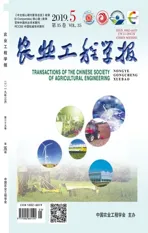黄河流域矿区充填复垦泥沙供需状况及输沙路径分析
2019-04-26殷守强于加春胡振琪杨超元
李 晶,殷守强,于加春,胡振琪,杨 震,杨超元
黄河流域矿区充填复垦泥沙供需状况及输沙路径分析
李 晶1,殷守强1,于加春1,胡振琪2,杨 震1,杨超元1
(1. 中国矿业大学(北京)地球科学与测绘工程学院,北京 100083;2. 中国矿业大学环境与测绘学院,徐州 221116)
引黄河泥沙充填复垦采煤沉陷地是减轻黄河淤积和提升矿区复垦率的有效途径,有助于改善区域生态环境。该文以黄河主要淤积河段及沿岸150 km范围内的23个国家规划矿区为研究区,分别采用沙量平衡法和开采沉陷预计法估算了黄河流域矿区充填复垦泥沙的供给量和需求量,初步分析了适宜引黄充填复垦矿区并设计了概略输沙路径。研究结果表明:1950—2013年,黄河主要淤积河段的总泥沙淤积量约为144.31亿t;截至2013年,各规划矿区充填复垦总需沙量约为225.12亿t;综合考虑泥沙供需状况和输沙距离2个因素,包头、义马、焦作、郑州、肥城、黄河北、淄博7个近距离矿区和乌海、平顶山、晋城、鹤壁、新汶5个中距离矿区适宜黄河泥沙充填复垦,需沙量和需调用水量分别为90.19和148.81亿t;各适宜充填复垦矿区的概略输沙路径长度处于21.98~109.02 km,总长度约为643 km。研究成果可为黄河泥沙充填复垦技术推广提供前期专题性基础数据,为后续可行性研究、规划设计及充填复垦等相关政策制定提供参考。
土地复垦;排水;煤矿;黄河流域;国家规划矿区;泥沙充填复垦;供需状况
0 引 言
黄河流域分布有全国9大煤炭基地,涉及58个国家规划矿区,为国家经济发展提供了大量煤炭资源,但同时也产生了大面积的采煤沉陷地甚至积水区[1],严重影响了矿区生产生活和生态环境状况。充填复垦采煤沉陷地和挖损地是提高矿区土地复垦率的重要途径之一,但由于煤矸石、粉煤灰等传统充填复垦材料数量不足等原因,目前中国矿区土地复垦率不到30%[2],且复垦后土地存在潜在污染性[3]。黄河作为连接河源、上中下游及河口等湿地生态单元的“廊道”,具有防洪蓄水、水源涵养等多种功能,但黄河以“水少沙多、含沙量高”而著称,部分河段持续淤积,严重影响了正常功能的发挥。为了减轻河道淤积,保障防洪安全,2013年国务院批复的《黄河流域综合规划(2012—2030年)》[4]明确提出了以“拦、排、调、放、挖”为重点的泥沙利用基本思路。引黄河淤积泥沙充填复垦采煤沉陷地,正是践行这一思路的有效途径。为保护河流生态环境和河道安全,目前国家实行采砂许可制度,限制泥沙开采,只要坚持趋利避害,选择适宜的区域和时段适度取沙,就能充分发挥引黄充填复垦的积极作用,同时改善河流和矿区生态环境。
目前,国内学者对引黄充填复垦的可行性、技术方法、效果等方面进行了研究。张梦虹等[5]、何强等[6]分析了引黄充填复垦的可行性。中国矿业大学(北京)胡振琪团队等针对引黄充填复垦进行了系统的理论研究和工程实践:通过开展黄河泥沙充填复垦的试验,比较了复垦土地与附近农田在地貌景观、理化性质、作物长势等方面的差异,论证了引黄充填复垦技术的可行性[7-8];胡振琪等[9-10]、邵芳等[11]、王培俊等[12]、朱琦等[13]、陈亚凯等[14]通过深入的研究,形成了包括取沙、输沙、填沙及土壤重构、沉沙后排水等泥沙充填复垦采煤沉陷地的整套技术体系,并在山东邱集煤矿等地开展了工程实践;许涛等[15]开展了引黄河泥沙充填复垦采煤沉陷地的区域适用性评价研究。
理论研究和工程实践表明,引黄充填复垦技术可行,有利于变“泥沙隐患为复垦之利”,提升矿区土地复垦率的同时改善河流和矿区生态环境,在黄河流域适宜河段和矿区推广这项技术意义重大。由于受多方面因素的影响,该项技术推广工作很难一蹴而就,需要分前期专题基础性研究、中期可行性研究和后期规划设计和施工等多个阶段完成。其中,黄河泥沙淤积和矿区采煤沉陷状况分别反映了引黄充填复垦泥沙的最大供给潜力和需求状况,是影响引黄充填复垦规模与布局的重要基础因素,但迄今为止,尚未见区域乃至国家等宏观尺度的相关 研究。
本文以黄河主要淤积河段及沿岸150 km范围内的23个国家规划矿区为研究范围,通过分析黄河主要淤积河段的泥沙供给与各矿区充填复垦泥沙需求的关系,据此概略划分出适宜引黄充填复垦的矿区,并设计各河段到矿区的概略输沙路径,以期为后续国家及区域复垦政策制定、引黄充填复垦可行性研究和相关规划等奠定前期探索性研究基础和提供参考。
1 区域概况
1.1 黄河水文概况
黄河西起巴颜喀拉山,东至渤海,北临阴山,南到秦岭,全长约5 464 km,流域面积达79.5 万km2,干流通常划分为上、中、下3段[16],不同河段的泥沙主要来源和淤积特征不同。黄河上游的兰州—头道拐河段,流域内有沙漠风积沙、十大“孔兑”所携带的泥沙汇入,其中巴彦高勒—头道拐河段为冲积性的平原型河道,每年有一定量的泥沙淤积,河床缓慢上升。头道拐—孟津的中游河段,流经黄土高原,土壤侵蚀严重,尽管河流含沙量较高,但流速极快,河道淤积程度较轻。孟津以下的河段,流域内植被覆盖度较高,土壤侵蚀程度很弱,区间来沙可忽略不计,由于河道宽广而平缓,水流缓而散乱,成为巨大的泥沙沉积场,逐渐演变为“地上河”。
按照水文观测站划分,黄河主要淤积河段包括上游的巴彦高勒—三湖河口、三湖河口—头道拐,中游的孟津—花园口,下游的花园口—高村、高村—艾山、艾山—利津,见图1。上述河段泥沙淤积比较严重,供沙潜力较大,采集泥沙更加有利。

图1 黄河水文观测站和主要淤积河段
1.2 黄河流域矿区分布概况
黄河流域分布有宁东、神东、陕北、晋北、晋中、黄陇、晋东、河南、鲁西9大煤炭基地,涉及58个全国规划矿区,总面积约为13.62万km2,主要分布在宁夏、内蒙古、陕西、山西、河南和山东等6个省级行政区,见图2。

图2 黄河流域国家规划矿区空间位置示意图
1.3 研究区范围和引黄充填复垦技术流程
相关研究与工程实践案例表明,国内外高浓度矿浆管道输送距离可达几百千米[17-20],但高浓度泥浆管道输沙距离最远只有160 km[21]。考虑到最远输沙距离的制约,本文以黄河主要淤积河段及其沿岸150 km范围内的23个国家规划矿区为研究区,并按照距离黄河0~60 km、>60~120 km和>120~150 km的空间差异,将矿区划分成近距离(S1)矿区、中距离(S2)矿区和远距离(S3)矿区3种类型。为便于计算和分析,矿区与黄河淤积河段的距离用矿区的几何中心点与黄河的最短距离表示。
引黄充填复垦技术流程如图3所示[7],包括:1)采用挖沙船切削河道淤积泥沙,使用潜沙泵设备将黄河河床冲起来的泥沙颗粒与水混合形成高浓度泥浆;2)应用输沙管道和加压泵站等,把高浓度泥浆运输到待复垦区域,泥沙输送过程不会对自然河道造成人工侵蚀破坏; 3)泥浆运输到待复垦区域后,采用沉沙排水技术,使 泥沙沉积充填待复垦区域,并把清水排到附近的沟渠、河道中,根据相关政策和地方用水需求,使之返回黄 河或者作为当地用水,确保充填复垦后水资源得到充分利用。

图3 引黄充填复垦技术流程
2 研究方法和数据来源
本文把黄河主要淤积河段作为充填复垦泥沙的供给河段,首先采用沙量平衡法估算这些河段的泥沙淤积量;然后运用开采沉陷预计法估算研究区范围内各矿区的充填复垦需沙量;在此基础上,分析引黄充填复垦泥沙的供需状况及其空间差异,初步划分适宜充填复垦矿区,并设计黄河到各矿区的概略输沙路径。
2.1 黄河泥沙淤积量的估算
黄河泥沙淤积量的估算方法包括同流量水位法、断面法、沙量平衡法等[22]。结合所搜集的数据资料,本文采用沙量平衡法[23]估算1950—2013年不同淤积河段的总淤积量,见式(1)。

从中国水利部发布的《2013年中国河流泥沙公报》[24]中,获取1950—2013年黄河不同水文观测站的累计输沙量数据。通过文献查阅、专家咨询、实地调查等方式,获取不同河段的区间来沙和取沙数据。其中,各河段区间来沙主要考虑流域内支流携带泥沙状况,区间取沙主要考虑引黄灌溉取沙、采沙场取沙和引黄充填复垦试验取沙3种途径。

孟津—花园口段,1990—2013年共建81个采沙场,年均取沙量约499万m3[27],历年累计取沙11 976万m3,按照黄河中游泥沙密度为2.73×103kg/m3[28]进行折算,采沙场累计取沙约3.27亿t;花园口—高村段,采沙场年取沙量约为99万m3[27],1990—2013年累计取沙2 376万m3,按黄河下游泥沙密度为2.71×103kg/m3[28]折算,累计取沙约为0.64亿t;高村—艾山段,采沙场年均取沙约20万m3[27],1990—2013年累计取沙480万m3,约为0.13亿t。
高村—艾山段,近年来山东省济宁市等开展了引黄充填复垦试验,泥沙输送浓度可达400 kg/m3,利用了约0.02亿t黄河泥沙[7,29],治理沉陷地面积约48.67 hm2。
黄河下游河道年均引黄灌溉取沙约0.8125亿t[30],1950—2013年累计引黄灌溉取沙量约为52.00亿t,分别按照引黄灌溉取沙比例为18%、30%、22.5%和29.5%[30-31]进行估算可知,孟津—花园口、花园口—高村、高村—艾山和艾山—利津的引黄灌溉累计取沙量分别为9.36、15.60、11.70和15.34亿t。
综上分析,分别汇总得到1950—2013年黄河主要淤积河段的区间取沙状况(表1)和泥沙输移状况(表2)。
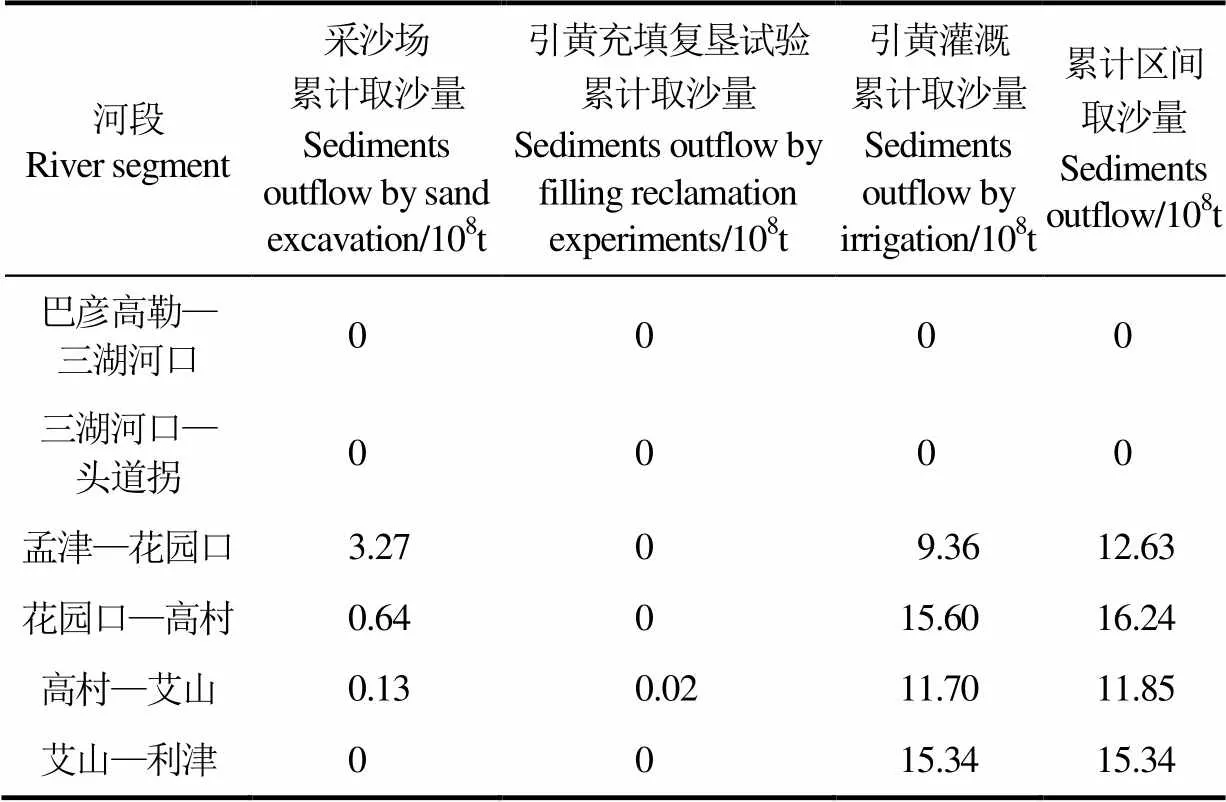
表1 1950—2013年黄河主要淤积河段的区间取沙状况
注:累计区间取沙量=采沙场累计取沙量+引黄充填复垦试验累计取沙量+引黄灌溉累计取沙量。
Note:Sediments outflow = sediments outflow by sand excavation + sediments outflow by filling reclamation experiments + sediments outflow by irrigation.

表2 1950—2013年黄河主要淤积河段的泥沙输移状况
2.2 引黄充填复垦需沙量的估算
估算各矿区的充填复垦需沙量,可以采用物理模拟试验、数值模拟分析、现场监测、理论分析预测等开采沉陷预计方法。其中,除了理论分析预测外,其余方法多针对某一矿山开采区域,对数据参数要求比较高[32]。基于煤炭产量和下沉系数的开采沉陷预计方法[6,33]是一种理论分析预测方法,不需要很复杂的数据,普遍适用于中宏观矿区的开采沉陷预计,应用该方法预计研究范围内各矿区的采煤沉陷体积和引黄充填复垦需沙量,见式(2)和式(3)。
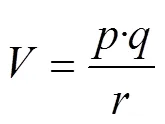

式中为采煤沉陷体积,亿m3;为引黄充填复垦需沙量,亿t;为煤炭产量,亿t;为下沉系数;为煤炭容重,t/m3;为泥沙平均密度,kg/m3。
从中国煤炭地质总局发布的《我国大型煤炭基地区域含水层保护战略研究》[34]中,获取截至2013年黄河流域9大煤炭基地国家规划矿区的煤炭产量数据。通过查找相关文献,获取不同矿区的下沉系数。为了便于估算,采用全国不同矿区各煤层的平均容重,约为1.4 t/m3[35-37]。黄河上游、中游和下游的泥沙平均密度分别为2.74×103、2.73×103和2.71×103kg/m3[28]。
2.3 概略输沙路径设计方法
输沙路径是指连接黄河到矿区采煤沉陷地的输沙管道布局线路。遵循“技术可行、经济合理”的原则,须统一设计各矿区的输沙路径,远距离矿区与近距离矿区统筹考虑,输沙管道建设相互衔接,由近及远,分步实施。不考虑地形、地类等其他因素的影响,应用ArcGIS最短路径分析功能,分析各矿区距离黄河主要淤积河段的最短距离及周围毗邻矿区距离,并计算S1、S2、S3矿区的概略输沙路径长度,见式(4)。
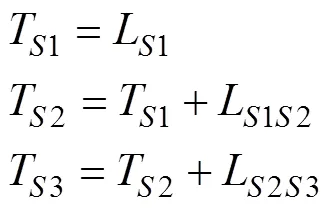
式中T1、T2、T3分别表示S1、S2、S3矿区的概略输沙路径长度,km;L1表示S1矿区与黄河主要淤积河段 的最短距离,km;L1S2表示S1矿区与周围S2矿区的 最短距离,km;L2S3表示S2矿区与周围S3矿区的最短距离,km。
3 结果与分析
3.1 充填复垦黄河泥沙供需状况及其空间差异
3.1.1 黄河主要淤积河段的泥沙淤积量
根据黄河主要淤积河段的泥沙输移状况(表2),采用式(1)估算出1950—2013年黄河主要淤积河段的泥沙淤积量。结果表明,1950—2013年黄河主要淤积河段的泥沙总淤积量约为144.31 亿t,年均淤积量约为2.25亿t。其中,孟津—花园口、花园口—高村的淤积程度最严重,总淤积量为114.75亿t,占所有主要淤积河段总淤积量的79.52%。与相关研究文献进行对比分析说明,见表3,本文对不同河段淤积量的估算结果相对可靠,与其他多数文献所得估算结果接近,能够较好地反映黄河主要淤积河段的泥沙淤积状况。
3.1.2 引黄充填复垦矿区的需沙量
研究区范围内共有23个国家规划矿区,包括淄博、肥城、黄河北、巨野、焦作、郑州、义马、准格尔和包头等9个S1矿区,新汶、兖州、济宁、鹤壁、平顶山、晋城、府谷、神东、万利、乌海等10个S2矿区,枣滕、潞安、霍东、霍州等4个S3矿区,见图4。
采用式(2)和式(3)估算出至2013年研究区范围内各国家规划矿区的充填复垦需沙量,见表4。经试验测定,当前技术条件下远距离管道输沙最大经济含沙量约为500 kg/m3[7],即每1 m3的泥浆包含约500 kg的泥沙。按照黄河泥沙密度统一取值为2.73×103kg/m3进行估算,1 m3的泥浆中含0.183 m3的黄河泥沙,泥沙与水的体积比约为1∶4.5,按照水的密度为1×103kg/m3估算可知,每充填1 亿m3的采煤沉陷空间需调用约4.5亿t的水资源。因此,可根据各矿区的采煤沉陷体积估算出各矿区的需调用黄河水量,见表4。
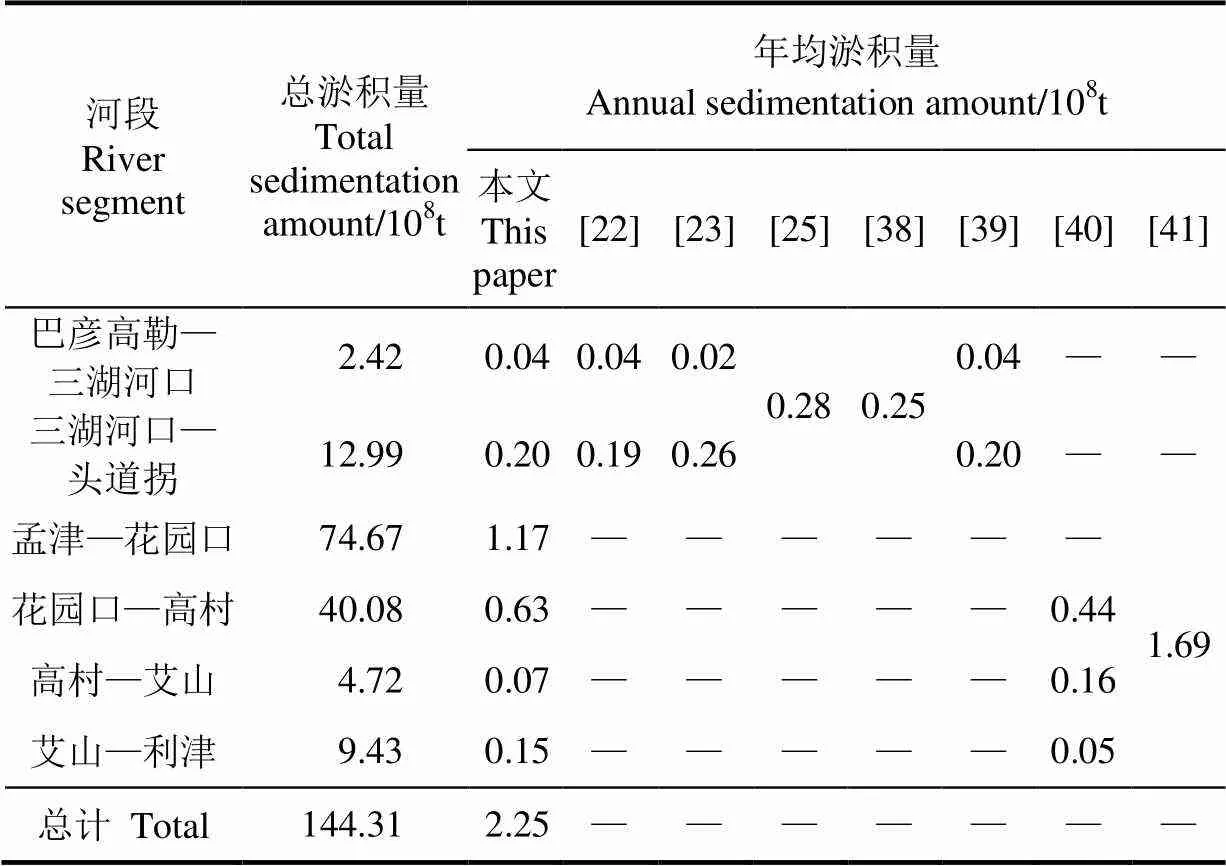
表3 黄河泥沙淤积量估算结果的文献对比情况
注:“—”表示相应河段没有参与计算,无对比数据。
Note:“—” means no data on the corresponding river segment for not involving in the calculation.

图4 研究区内国家规划矿区及其距黄河最短距离
截至2013年,研究区范围内各矿区的充填复垦总需沙量为225.12亿t,累计需调用黄河水量371.16亿t。其中,S1、S2和S3矿区的需沙量分别约为72.86、111.62和40.64亿t,分别占总需沙量的32.36%、49.58%和18.05%。神东、河南、鲁西、晋东、晋中煤炭基地的需沙量分别约为67.81、58.70、46.49、26.21和25.91亿t,分别占总需沙量的30.12%、26.07%、20.65%、11.64%和11.51%。
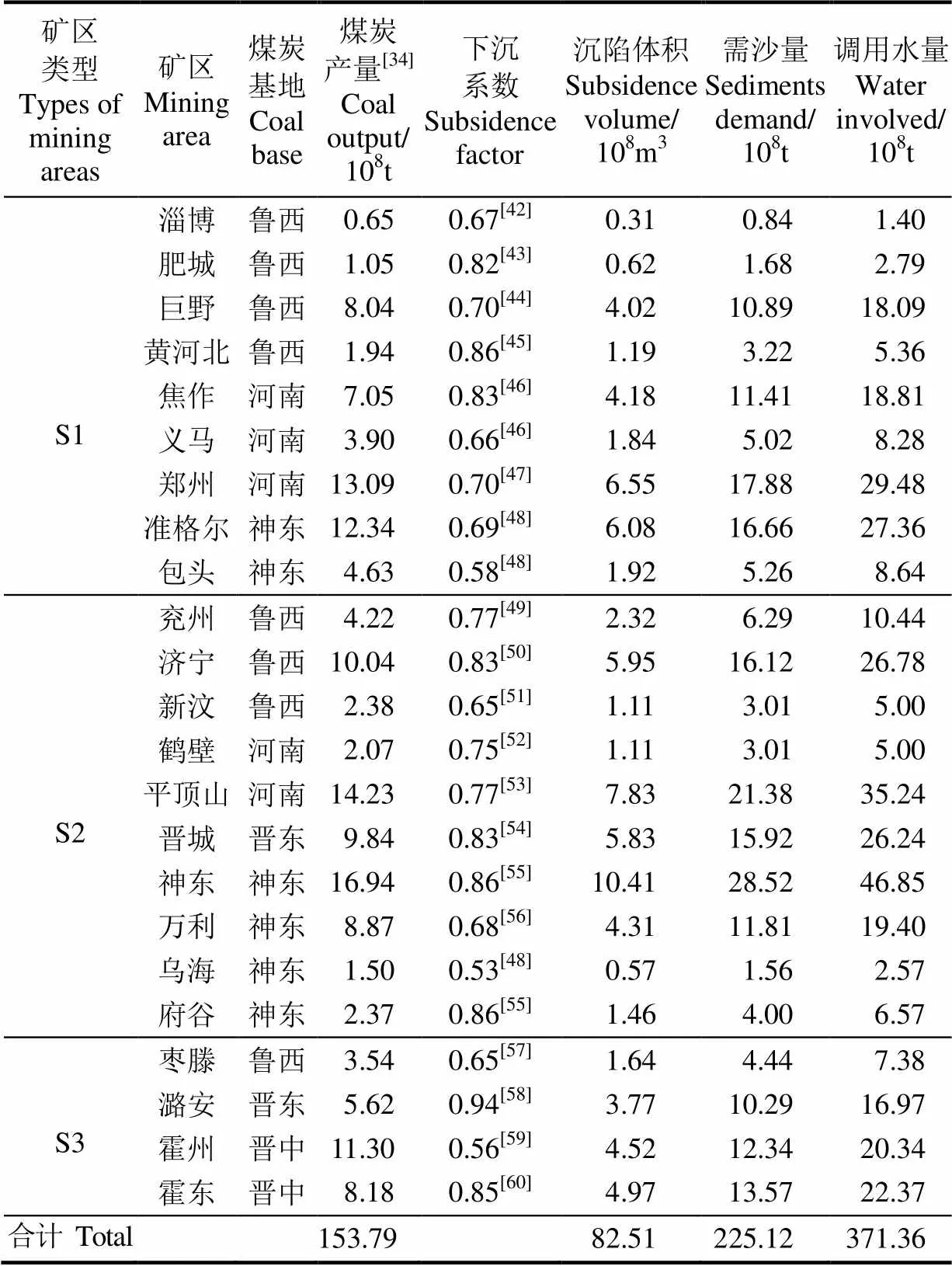
表4 研究区范围内国家规划矿区的充填复垦需沙量和需调用水量
3.1.3 充填复垦黄河泥沙供需状况空间差异分析
表5中黄河主要淤积河段的总泥沙淤积量小于研究范围内矿区充填复垦的总需沙量,供需差距为80.81亿t。其中,巴彦高勒—三湖河口、花园口—高村和艾山—利津3个河段,泥沙淤积量分别为2.42、40.08和9.43亿t,各河段沿岸150 km范围内矿区的充填复垦需沙量分别为1.56、3.01和8.75亿t,泥沙供给量均大于需求量,因此仅考虑充填物料是否充足这项因素,这3个河段沿岸所有矿区均适宜采用黄河泥沙充填复垦。三湖河口—头道拐、孟津—花园口和高村—艾山3个河段,泥沙淤积量分别为12.99、74.67和4.72亿t,各河段沿岸150 km范围内矿区的需沙量分别为66.25、107.81和37.74亿t,泥沙供给量远小于需求量,因此考虑到黄河泥沙供需状况,这3个河段沿岸部分矿区适宜采用黄河泥沙充填复垦,为了节约输沙成本,按照距黄河由近到远的顺序确定适宜充填复垦矿区。
综上分析,综合考虑充填复垦泥沙量供需状况和输沙距离的制约,黄河沿岸适宜充填复垦矿区包括包头、义马、焦作、郑州、肥城、黄河北、淄博7个S1矿区和乌海、平顶山、晋城、鹤壁、新汶5个S2矿区,需沙量分别为45.31和44.88亿t,总计为90.19亿t,见表5,占研究区范围内国家规划矿区总需沙量的40.06%,相当于黄河主要淤积河段总淤积量的62.50%,黄河泥沙充填复垦矿区需累计调用黄河水量约为148.81 亿t。从经济合理、工程技术便于操作、生态安全等角度综合考虑,引黄充填复垦工程宜有选择地分期推广,且泥沙充填复垦完沉沙回水后,大部分水仍将返回黄河,不会影响黄河供水安全。
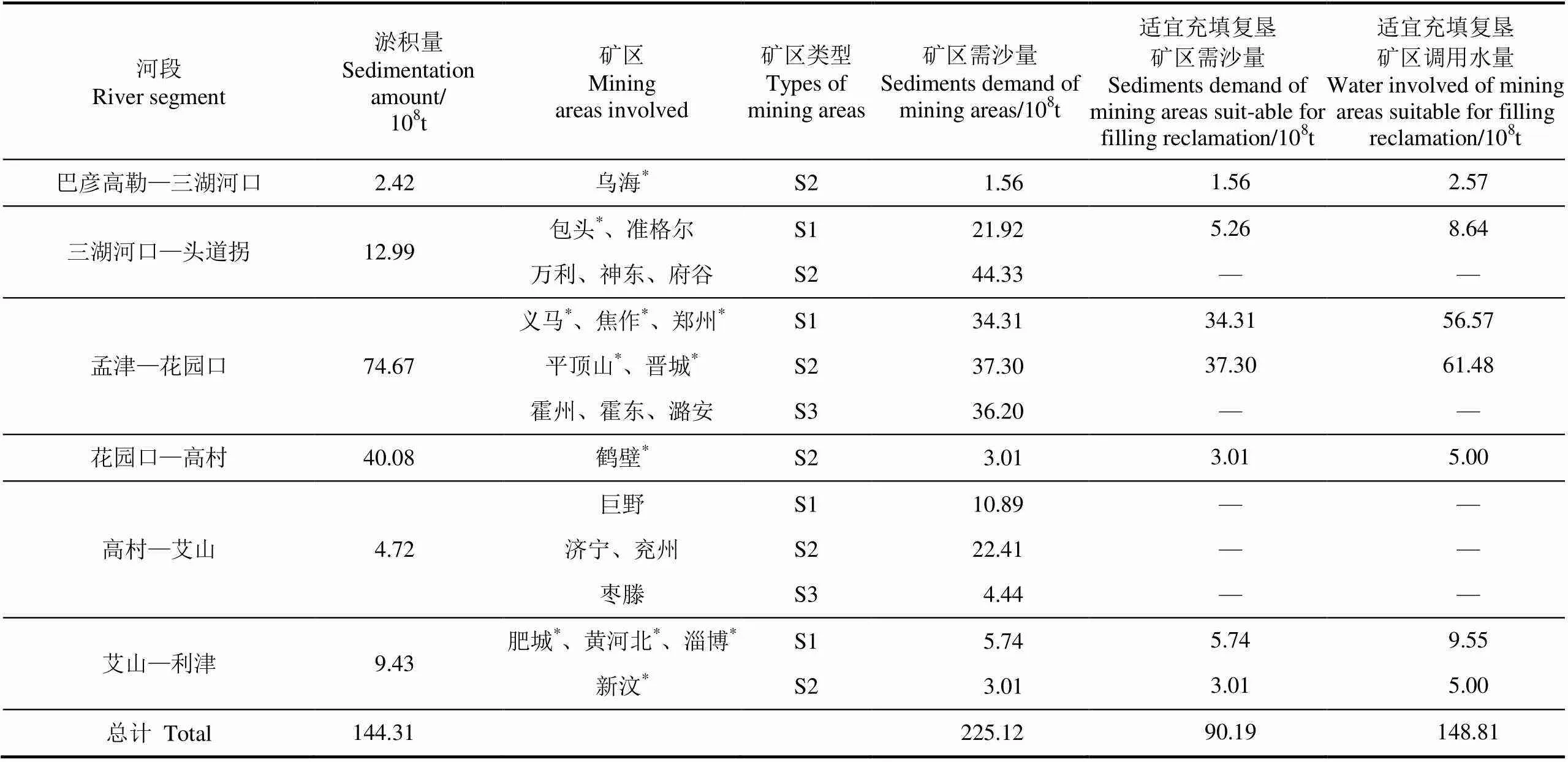
表5 不同河段矿区充填复垦泥沙供需状况
注:“*”表示适宜充填复垦矿区,“—”表示相应矿区没有参与计算,无对比数据。
Note: “*”denotes the suitable filling reclamation mining area, “—” means no data on the corresponding mining areas for not being involved in the calculation.
3.2 概略输沙路径分析
在图4基础上,按照式(4)概略设计出适宜充填复垦矿区的输沙路径并计算其长度,见图5和表6。适宜充填复垦矿区的概略输沙路径长度范围为21.98~109.02 km,总长度为643 km。其中,肥城、黄河北、焦作、郑州等4个矿区概略输沙路径长度小于30 km,淄博、义马矿区为30~50 km,包头、鹤壁、晋城、平顶山、新汶、乌海矿区为>50~110 km,其中乌海矿区的输沙路径最长,约为109.02 km。

图5 适宜充填复垦矿区的概略输沙路径
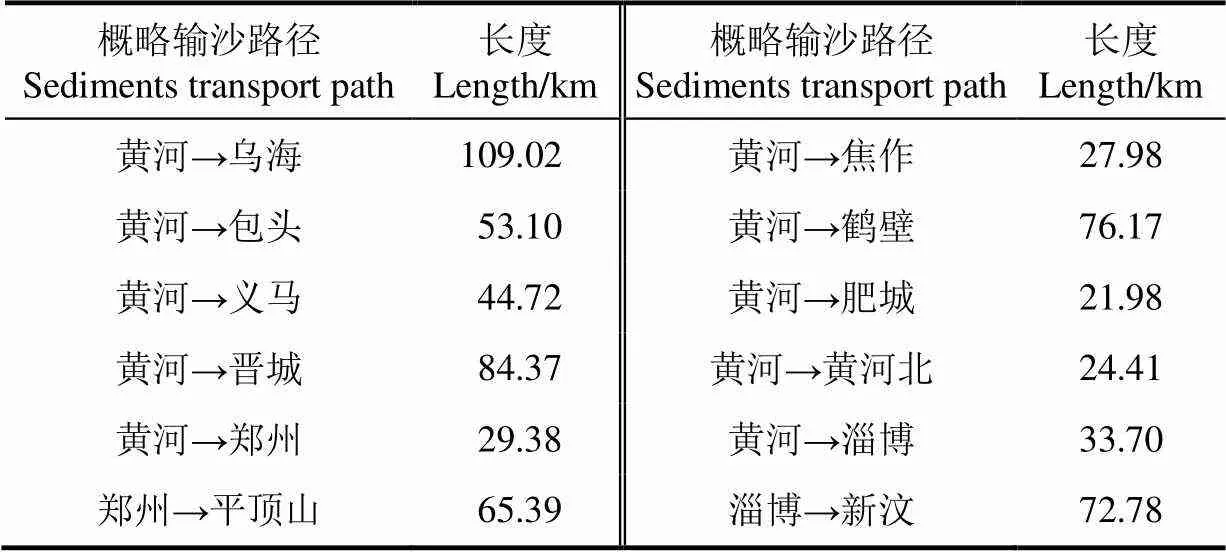
表6 适宜充填复垦矿区的概略输沙路径长度
4 结 论
本文以黄河主要淤积河段及沿岸150 km范围内的23个国家规划矿区为研究范围,估算了矿区充填复垦泥沙供需状况和输沙距离,分析了适宜引黄充填复垦的矿区,并设计了概略输沙路径。结论如下:
1)1950—2013年,黄河主要淤积河段的泥沙淤积量约为144.31亿t;截至2013年,研究区范围内各矿区充填复垦总需沙量约为225.12亿t。
2)巴彦高勒—三湖河口、花园口—高村和艾山—利津,泥沙供给量大于需求量,沿岸所有矿区适宜引黄充填复垦;三湖河口—头道拐、孟津—花园口和高村—艾山,泥沙供给量小于需求量,沿岸部分矿区适宜引黄充填复垦。综合考虑充填复垦泥沙供需状况和输沙距离的制约,包头、义马、焦作、郑州、肥城、黄河北、淄博7个近距离矿区和乌海、平顶山、晋城、鹤壁、新汶5个中距离矿区划分为适宜充填复垦矿区,需沙量和需调用水量分别为90.19和148.81亿t。
3)适宜充填复垦矿区的概略输沙路径长度处于21.98~109.02 km,总长度约为643 km。肥城、黄河北、焦作、郑州等4个矿区概略输沙路径最短,乌海矿区最长。
本文从宏观区域尺度分析了黄河泥沙淤积量与矿区充填复垦需沙量的供需状况,从泥沙供给关系、输沙距离2个制约因素角度分析了适宜充填复垦矿区,研究成果可以作为引黄充填复垦技术推广应用的前期专题研究基础,为充填复垦可行性研究、规划设计和施工及充填复垦等国家和区域政策制定提供参考。针对顾及因素少、仅考虑泥沙供需关系和距离因素等不足,今后可采用演绎法,逐一叠加不同河段的自然生态状况、其他用途的需水需沙状况、水沙开采限制政策、各矿区已复垦情况、不同区域土地复垦的必要性和急迫性、最新观测泥沙量数据和更加精准的沉陷监测数据等因素进行修正,使研究成果更具前瞻性、指导性和可操作性。
[1] 李晶,申莹莹,焦利鹏,等. 基于Landsat TM/OLI影像的兖州煤田水域面积动态监测[J]. 农业工程学报,2017,33(18):243-250. Li Jing, Shen Yingying, Jiao Lipeng, et al. Dynamic monitoring of water areas in Yanzhou coalfield based on Landsat TM/OLI images[J]. Transactions of the Chinese Society of Agricultural Engineering (Transactions of the CSAE), 2017, 33(18): 243-250. (in Chinese with English abstract)
[2] 丁翔,白中科. 煤矿城市土地生态安全评价与预测:以山西省朔州市为例[J]. 中国矿业,2018,27(3):81-86. Ding Xiang, Bai Zhongke. Evaluation and prediction of land ecological security in coal mine city: A case study of Shuozhou City, Shanxi Province[J]. China Mining Magazine, 2018, 27(3): 81-86. (in Chinese with English abstract)
[3] 徐良骥,黄璨,章如芹,等. 煤矸石充填复垦地理化特性与重金属分布特征[J]. 农业工程学报,2014,30(5): 211-219. Xu Liangji, Huang Can, Zhang Ruqin, et al. Physical and chemical properties and distribution characteristics of heavy metals in reclaimed land filled with coal gangue[J]. Transactions of the Chinese Society of Agricultural Engineering (Transactions of the CSAE), 2014, 30(5): 211-219. (in Chinese with English abstract)
[4] 水利部黄河水利委员会. 黄河流域综合规划(2012-2030年)[M]. 郑州:黄河水利出版社,2013.
[5] 张梦虹, 吴侃. 济宁北部矿区引黄河泥沙充填复垦优化分析[J]. 金属矿山, 2016, 45(5):158-162. Zhang Menghong, Wu Kan. Optimization analysis of Yellow River sediment reclamation in the northern mining area of Jining[J]. Metal Mine, 2016, 45(5): 158-162. (in Chinese with English abstract)
[6] 何强,吴侃,许冬,等. 南四湖流域采煤沉陷区引黄复垦需沙量估算与分析[J]. 中国矿业,2015,24(2):67-71. He Qiang, Wu Kan, Xu Dong, et al. Estimation and analyses of sediment demand in the reclamation with the Yellow River in the mining subsidence land of Nansihu Lake drainage area[J]. China Mining Magazine, 2015, 24(2): 67-71. (in Chinese with English abstract)
[7] 胡振琪,王培俊,邵芳. 引黄河泥沙充填复垦采煤沉陷地技术的试验研究[J]. 农业工程学报,2015,31(3):288-295. Hu Zhenqi, Wang Peijun, Shao Fang. Technique for filling reclamation of mining subsidence land with Yellow River sediment[J]. Transactions of the Chinese Society of Agricultural Engineering (Transactions of the CSAE), 2015, 31(3): 288-295. (in Chinese with English abstract)
[8] 胡振琪,邵芳,多玲花. 黄河泥沙间隔条带式充填采煤沉陷地复垦技术及实践[J]. 煤炭学报,2017,42(3):557-566. Hu Zhenqi, Shao Fang, Duo Linghua. Technique of reclaiming subsided land with Yellow River sediments in the form of spaced strips[J]. Journal of China Coal Society, 2017, 42(3): 557-566. (in Chinese with English abstract)
[9] Hu Zhenqi, Shao Fang, Mcsweeney K, et al. Reclaiming subsided land with Yellow River sediments: Evaluation of soil-sediment columns[J]. Geoderma, 2017, 307(23): 210-219.
[10] 胡振琪,多玲花,王晓彤. 采煤沉陷地夹层式充填复垦原理与方法[J]. 煤炭学报,2018,43(1):198-206. Hu Zhenqi, Duo Linghua, Wang Xiaotong. Principle and method of reclaiming subsidence land with inter-layers of filling materials[J]. Journal of China Coal Society, 2018, 43(1): 198-206. (in Chinese with English abstract)
[11] 邵芳,胡振琪,王培俊,等. 基于黄河泥沙充填复垦采煤沉陷地覆土材料的优选[J]. 农业工程学报,2016,32(增刊 2):352-358. Shao Fang, Hu Zhenqi, Wang Peijun, et al. Selection of alternative soil for filling reclamation with Yellow River sediment in coal-mining subsidence areas[J]. Transactions of the Chinese Society of Agricultural Engineering (Transactions of the CSAE), 2016, 32(Supp. 2): 352-358. (in Chinese with English abstract)
[12] 王培俊,胡振琪,邵芳,等. 黄河泥沙作为采煤沉陷地充填复垦材料的可行性分析[J]. 煤炭学报,2014,39(6): 1133-1139. Wang Peijun, Hu Zhenqi, Shao Fang, et al. Feasibility analysis of Yellow River sediment used as the filling reclamation material of mining subsidence land[J]. Journal of China Coal Society, 2014, 39(6): 1133-1139. (in Chinese with English abstract)
[13] 朱琦,胡振琪,王培骏,等. 济宁市采煤沉陷地引黄充填沉沙排水量预测及利用效益分析[J]. 金属矿山,2016,45(11):63-68. Zhu Qi, Hu Zhenqi, Wang Peijun, et al. Drainage quantity forecasting and efficiency assessment on filling reclamation of mining subsidence land with Yellow River sediment in Jining[J]. Metal Mine, 2016, 45(11): 63-68. (in Chinese with English abstract)
[14] 陈亚凯,邵芳,乔志勇. 黄河泥沙充填复垦耕地表层土壤垂直入渗特性研究[J]. 中国生态农业学报,2014,22(7):798-805. Chen Yakai, Shao Fang, Qiao Zhiyong. Vertical infiltration characteristics of reclaimed farmland soils with Yellow River sediment fill[J]. Chinese Journal of Eco-Agriculture, 2014, 22(7): 798-805. (in Chinese with English abstract)
[15] 许涛,赵艳玲,肖武,等. 引黄河泥沙充填复垦采煤沉陷地区域适用性评价:以济宁市为例[J]. 中国农业大学学报,2017, 22(2):106-114. Xu Tao, Zhao Yanling, Xiao Wu, et al. The regional suitability evaluation index system of filling reclamation of mining subsidence land with Yellow River sediment: A case study of Jining City[J]. Journal of China Agricultural University, 2017, 22(2): 106-114. (in Chinese with English abstract)
[16] 赵玉,穆兴民,何毅,等. 1950-2011年黄河干流水沙关系变化研究[J]. 泥沙研究,2014,39(4):32-38. Zhao Yu, Mu Xingmin, He Yi, et al. Relationship between runoff and sediment discharge in the main channel of Yellow River from 1950 to 2011[J]. Journal of Sediment Research, 2014, 39(4): 32-38. (in Chinese with English abstract)
[17] Gandhi R L, Norwood J, Che Y. Cross-country bauxite slurry transportation[M]// Don Donaldson, Benny E. Essential readings in light metals. New York, USA: Springer International Publishing Company, 2016: 70-74.
[18] Cowper S N T, Cowper J N T, Thomas A D. Slurry pipelines: Past, present and future[J]. Australian Journal of Multi- disciplinary Engineering, 2009, 7(2): 189-196.
[19] Bhabra H. Slurry pipeline now goes the distance[J]. World Pumps, 2013, 2013(6): 38-40.
[20] 陈光国,夏建新. 我国矿浆管道输送技术水平与挑战[J]. 矿冶工程,2015,35(2):29-32,37. Chen Guangguo, Xia Jianxin. Existing technology and technical challenges in slurry pipeline transportation development in China[J]. Mining and Metallurgical Engineering, 2015, 35(2): 29-32, 37. (in Chinese with English abstract)
[21] Welp T, Ray G. Application of long distance conveyance of dredged sediment to Louisiana coastal restoration[R]. Vicksburg, Mississippi, USA: Army Engineer Research and Development Center, 2011.
[22] 侯素珍,王平,郭秀吉,等. 黄河内蒙古段河道泥沙淤积对水沙的响应[J]. 泥沙研究,2015,40(1):61-66. Hou Suzhen, Wang Ping, Guo Xiuji, et al. Responses of river sedimentation to water-sediment conditions in Inner Mongolia reach of upper Yellow River[J]. Journal of Sediment Research, 2015, 40(1): 61-66. (in Chinese with English abstract)
[23] 安催花,鲁俊,钱裕,等. 黄河宁蒙河段冲淤时空分布特征与淤积原因[J]. 水利学报,2018,49(2):1-13. An Cuihua, Lu Jun, Qian Yu, et al. Spatial-temporal distribution characteristic and course of sedimentation in the Ningxia-Inner Mongolia reaches of the Yellow River[J]. Journal of Hydraulic Engineering, 2018, 49(2): 1-13. (in Chinese with English abstract)
[24] 中华人民共和国水利部. 2013年中国河流泥沙公报[M]. 北京:中国水利水电出版社,2014.
[25] 杨根生,拓万全,戴丰年,等. 风沙对黄河内蒙古河段河道泥沙淤积的影响[J]. 中国沙漠,2003,23(2):54-61. Yang Gensheng, Tuo Wanquan, Dai Fengnian, et al. Contribution of sand sources to the silting of riverbed in Inner Mongolia segment of Huanghe River[J]. Journal of Desert Research, 2003, 23(2): 54-61. (in Chinese with English abstract)
[26] 林秀芝,郭彦,侯素珍. 内蒙古十大孔兑输沙量估算方法探讨[J]. 泥沙研究,2014,39(2):16-20. Lin Xiuzhi, Guo Yan, Hou Suzhen. Estimation of sediment discharge of ten tributaries of Yellow River in Inner Mongolia[J]. Journal of Sediment Research, 2014, 39(2): 16-20. (in Chinese with English abstract)
[27] 行红磊,许发文,行鑫鑫. 浅谈河南黄河泥砂利用的有效方式与途径[C]// 2015第七届全国河湖治理与水生态文明发展论坛论文集. 北京:中国水利技术信息中心,2015:56-60.
[28] 和瑞莉,李静,张石娃. 黄河流域泥沙密度试验研究[J]. 人民黄河,1999,21(3):8-10,49. He Ruili, Li Jing, Zhang Shiwa. Experimental study of sediment density in the Yellow River basin[J]. Yellow River, 1999, 21(3): 8-10, 49. (in Chinese with English abstract)
[29] 江恩慧,曹永涛,董其华,等. 黄河泥沙资源利用的长远效应[J]. 人民黄河,2015,37(2):1-5,12. Jiang Enhui, Cao Yongtao, Dong Qihua, et al. Long term effects of the Yellow River sediment resources utilization[J]. Yellow River, 2015, 37(2): 1-5, 12. (in Chinese with English abstract)
[30] 徐建华,张培德,林银平,等. 时段划分对黄河下游灌溉引沙量计算值的影响[J]. 西北水资源与水工程学报,1998(3):49-51.
[31] 林秀芝,刘琦,曲少军. 黄河下游引水引沙对河道冲淤调整影响分析[J]. 泥沙研究,2010,35(6):44-49. Lin Xiuzhi, Liu Qi, Qu Shaojun. Impact of diverted water and sediment on erosion and deposition in Lower Yellow River[J]. Journal of Sediment Research, 2010, 35(6): 44-49. (in Chinese with English abstract)
[32] 代张音,江泽标,张路. 顺层岩质斜坡开采沉陷预测模型研究[J]. 岩石力学与工程学报,2017,36(12):3012-3020. Dai Zhangyin, Jiang Zebiao, Zhang Lu. A model for predicting mining subsidence in bedding rock slopes[J]. Chinese Journal of Rock Mechanics and Engineering, 2017, 36(12): 3012-3020. (in Chinese with English abstract)
[33] 贺一波,吴侃. 济宁矿区北区引黄河泥沙充填复垦限制因素及协调措施[J]. 煤矿开采,2016,21(4):95-99. He Yibo, Wu Kan. Limitation factors and coordinate measures of filling reclamation with silt of Yellow River in the north part of Jining mine district[J]. Coal Mining Technology, 2016, 21(4): 95-99. (in Chinese with English abstract)
[34] 中国煤炭地质总局水文地质局. 我国大型煤炭基地区域含水层保护战略研究[R]. 邯郸:中国煤炭地质总局水文地质局,2013.
[35] 刘海燕. 兖州煤田主采煤层顶板稳定性评价[D]. 青岛:山东科技大学,2004. Liu Haiyan. Evaluation of the Stability of Main Coal Seam’s Roof in Yanzhou Coalfield[D]. Qingdao: Shandong University of Science and Technology, 2004. (in Chinese with English abstract)
[36] 刘小琼. 滕北矿区太原组沉积特征与聚煤规律研究[D]. 青岛:山东科技大学,2007. Liu Xiaoqiong. Study of Sedimentary Characteristics and the Law of Coal Accumulation of Taiyuan Formation in Tengbei Coal Mine[D]. Qingdao: Shandong University of Science and Technology, 2007. (in Chinese with English abstract)
[37] 于健浩. 急倾斜煤层充填开采方法及其围岩移动机理研究[D]. 北京:中国矿业大学(北京),2013. Yu Jianhao. Research of Steep Seam Backfill Mining Methods and Its Mechanism of Surrounding Rock Movement[D]. Beijing: China University of Mining and Technology (Beijing), 2013. (in Chinese with English abstract)
[38] 张洪宇,申红彬. 孔兑入汇对黄河内蒙古段河道淤积的影响[J]. 人民黄河,2017,39(3):5-9. Zhang Hongyu, Shen Hongbin. Impact of tributaries inflow on channel sedimentation in Inner Mongolia reach of Yellow River[J]. Yellow River, 2017, 39(3): 5-9. (in Chinese with English abstract)
[39] 周丽艳,鲁俊,张建. 黄河宁蒙河段沙量平衡法冲淤量的计算及修正[J]. 人民黄河,2008,30(7):30-31.
[40] 马睿,韩铠御,钟德钰,等. 不同治理方案下黄河下游河道的冲淤变化研究[J]. 人民黄河,2017,39(12):37-46. Ma Rui, Han Kaiyu, Zhong Deyu, et al. Study on the riverbed erosion and deposition for different training schemes in the Lower Yellow River[J]. Yellow River, 2017, 39(12): 37-46. (in Chinese with English abstract)
[41] 李洁,夏军强,邓珊珊,等. 近30年黄河下游河道深泓线摆动特点[J]. 水科学进展,2017,28(5):652-661. Li Jie, Xia Junqiang, Deng Shanshan, et al. Characteristics of channel thalweg migration in the lower Yellow River over the past 30 years[J]. Advances in Water Science, 2017, 28(5): 652-661. (in Chinese with English abstract)
[42] 郭振忠,周业亭,孙少磊. 基于许厂煤矿厚松散层下开采地表沉陷规律研究与应用[J]. 中国高新技术企业,2012,18(22):128-129.
[43] 林育秀. 肥城矿区地表移动变形参数规律研究[D]. 青岛:山东科技大学,2007. Lin Yuxiu. Study on the Laws of Parameters of Surface Movement and Deformation on Feicheng Mining Area[D]. Qingdao: Shandong University of Science and Technology, 2007. (in Chinese with English abstract)
[44] 李晨. 巨野龙固矿井塌陷区农业园区规划研究[D]. 泰安:山东农业大学,2013. Li Chen. The Plan of Agricultural Park in Juye Longgu Mine Subsidence Area[D]. Taian: Shandong Agricultural University, 2013. (in Chinese with English abstract)
[45] 徐乃忠,葛少华,林英良,等. 山东黄河北煤田地表沉陷规律研究[J]. 煤炭科学技术,2011,39(6):97-101. Xu Naizhong, Ge Shaohua, Lin Yingliang, et al. Study on Shandong coalfield surface subsidence law in the north of Yellow River[J]. Coal Science & Technology, 2011, 39(6): 97-101. (in Chinese with English abstract)
[46] 郭文兵,邓喀中,邹友峰. 地表下沉系数计算的人工神经网络方法研究[J]. 岩土工程学报,2003,25(2):212-215. Guo Wenbing, Deng Kazhong, Zou Youfeng. Study on artificial neural network method for calculation of subsidence coefficient[J]. Chinese Jounal of Geotechnical Engineering, 2003, 25(2): 212-215. (in Chinese with English abstract)
[47] 龚望书. 郑州矿区规划环评中的地表沉陷预测探讨[J]. 中国西部科技,2011,10(2):6-7.
[48] 岳明. 神东风积沙矿区开采沉陷主要影响因素研究[D]. 包头:内蒙古科技大学,2014. Yue Ming. The Research of Shen-dong Aeolian Sand Mining Area of Main Influencing Factors of Mining Subsidence[D]. Baotou: Inner Mongolia University of Science & Technology, 2014. (in Chinese with English abstract)
[49] 郝国伟,王登振,安泰. 南屯煤矿33上02工作面开采沉陷预计分析[J]. 山东煤炭科技,2016,34(5):50-51.Hao Guowei, Wang Dengzhen, An Tai. Prediction and analysis of mining subsidence of Nantun coal mine 3302 working face[J]. Shandong Coal Science & Technology, 2016, 34(5): 50-51. (in Chinese with English abstract)
[50] 邓丽. 煤—粮复合区耕地保护问题研究——以济宁市为例[D]. 曲阜:曲阜师范大学,2010. Deng Li. Study on the Protection of Farmland in the Coal-grain Complex Area: A Case Study of Jining City[D]. Qufu: Qufu Normal University, 2010. (in Chinese with English abstract)
[51] 李松涛. 基于GIS的新汶矿区地表沉陷规律系统研究[D]. 青岛:山东科技大学,2005. Li Songtao. Study on the Surface Subsidence Law of Xinwen Mining Area Based on GIS[D]. Qingdao: Shandong University of Science and Technology, 2005. (in Chinese with English abstract)
[52] 谢和平,周宏伟,王金安,等. FLAC在煤矿开采沉陷预测中的应用及对比分析[J]. 岩石力学与工程学报,1999,18(4):397-401. Xie Heping, Zhou Hongwei, Wang Jinan, et al. Application of FLAC to predict ground surface displacements due to coal extraction and its comparative analysis[J]. Chinese Journal of Rock Mechanics & Engineering, 1999, 18(4): 397-401. (in Chinese with English abstract)
[53] 赵晓峰. 榆林某煤矿采空区地表移动变形预测及其工程分区[J]. 煤田地质与勘探,2011,39(4):39-42. Zhao Xiaofeng. Prediction and engineering division of the ground movement and deformation above the gob of a coal mine in Yulin[J]. Coal Geology & Exploration, 2011, 39(4): 39-42. (in Chinese with English abstract)
[54] 薛明科,汪玉松,王俊. 隆东煤矿开采沉陷预测分析[J]. 工矿自动化,2013,39(10):39-43. Xue Mingke, Wang Yusong, Wang Jun. Prediction and analysis of mining subsidence in Longdong coal mine[J]. Industry & Mine Automation, 2013, 39(10): 39-43. (in Chinese with English abstract)
[55] 汤伏全,姚顽强,夏玉成. 薄基岩下浅埋煤层开采地表沉陷预测方法[J]. 煤炭科学技术,2007,35(6):108-110,71. Tang Fuquan, Yao Wanqiang, Xia Yucheng. Prediction method of ground subsidence for coal mining in seam under thin base rock[J]. Coal Science & Technology, 2007, 35(6): 108-110,71.. (in Chinese with English abstract)
[56] 李杰. 万利矿区浅埋煤层开采地表移动变形规律[J]. 煤矿开采,2013,18(4):8-13. Li Jie. Surface movement and deformation rule of mining shallow-buried coal-seam in Wanli mining area[J]. Coal Mining Technology, 2013, 18(4): 8-13. (in Chinese with English abstract)
[57] 黄先栋. 高潜水位采煤沉陷耕地报损核减标准与制度设计[D]. 北京:中国矿业大学(北京),2017. Huang Xiandong. The Verification-reduction Standard and System Design of Subsided Farmland in High Groundwater Coal Mines[D]. Beijing: China University of Mining and Technology (Beijing), 2017. (in Chinese with English abstract)
[58] 郝兵元,胡海峰,白文斌,等. 地表沉陷预测参数可靠性分析及取值优化研究[J]. 太原理工大学学报,2011,42(2):184-187. Hao Bingyuan, Hu Haifeng, Bai Wenbin, et al. Reliability analysis and optimization of value on parameters of surface subsidence prediction[J]. Journal of Taiyuan University of Technology, 2011, 42(2): 184-187. (in Chinese with English abstract)
[59] 李春意,高永格,崔希民. 基于正态分布时间函数地表动态沉陷预测研究[J]. 岩土力学,2016,37(增刊 1):108-116. Li Chunyi, Gao Yongge, Cui Ximin. Progressive subsidence prediction of ground surface based on the normal distribution time function[J]. Rock & Soil Mechanics, 2016, 37(Supp. 1): 108-116. (in Chinese with English abstract)
[60] 王红军. 黄土坡煤矿地表沉陷预测及影响分析[J]. 山西煤炭,2010,30(12):48-50. Wang Hongjun. Prediction and influence analysis on surface subsidence in Huangtupo mine[J]. Shanxi Coal, 2010, 30(12): 48-50. (in Chinese with English abstract)
Analysis of supply-demand and transportation path of sediments for filling reclamation of mining areas in Yellow River basin
Li Jing1, Yin Shouqiang1, Yu Jiachun1, Hu Zhenqi2, Yang Zhen1, Yang Chaoyuan1
(1.100083,; 2.221116,)
Subsided mined-land reclamation with Yellow River Sediments is an effective way and a win-win strategy for reducing the Yellow River sedimentation and accelerating mined land reclamation by using sediments as filling materials, which is of great significance to improve the regional ecological environment. In order to analyze the maximal supply amount and sediments demand for the filling reclamation of mining areas in the Yellow River basin, in this paper, we took the Yellow River and 23 national planning mining areas within 150 km away from the main sediments deposition segments of the Yellow River as the study area. Through the analysis of supply and demand of sediments for the filling reclamation of mining areas, the river segments and mining areas suitable for filling reclamation were preliminarily identified and the schematic sediments transport paths were also designed. Firstly, the sediments balance equation was used to estimatethe sedimentation amount in main sediments deposition segments of the Yellow River in 1950-2013. Secondly, the sediments demand for filling reclamation of all mining areas withinthe study area was estimated. Based on the above two steps, we analyzed the spatial difference on the relation of Yellow River sediments supply and demand for the filling reclamation in all main sediments deposition segments. Finally, the sediments transport paths of different mining areas were designed as a whole by following the principle that the path should be shortest for minimum construction and labor costs involved. The results showed that the main sediments deposition segments of the Yellow River are Bayangol-Toudaoguai and Mengjin-Lijin, whose total sedimentation amount was 14.431 billiontons in 1950 -2013.Therefore, the sedimentation was the most serious in the river segment called Mengjin-Gaocun, where the accumulated sedimentation amount was 11.475 billion tons in 1950-2013. By the distance difference from the Yellow River, those 23 mining areas were further divided into three types of mining groups, including nine short-distance (S1) mining areas, 10 middle-distance (S2) mining areas, and four long-distance (S3) mining areas, which were 0 - 60 km, >60 - 120 km and >120 - 150 km away from the Yellow River, respectively. Their total sediments demand amount was about 22.512 billion tons by 2013. The spatial relationship between the supply and demand of the Yellow River sediments was unbalanced, thus not all mining areas could be reclaimed with Yellow River Sediment for insufficient sediment in some river segments. In the river segments including Bayangol-Sanhuhekou, Huayuankou-Gaocun, Aishan-Lijin, the sedimentation amount could cover the reclamation demand, thus all the mining areas could be filling-reclaimed using the sediments only judging by the difference between the sediment supply and reclamation demand, but in the river segments including Sanhuhekou-Toudaoguai, Mengjin-Huayuankou and Gaocun-Aishan, the sedimentation amount was less than the reclamation demand, thus only part of the mining areas could be suitable for the sediment-filling reclamation application. As a result, 7 S1 mining areas and 5 S2 mining areas, including Baotou, Yima, Jiaozuo, Zhengzhou, Feicheng, Huang Hebei, Zibo, Wuhai, Pingdingshan, Jincheng, Hebi and Xinwen, were comparatively suitable for filling reclamation by both sediments transportation length and sediments sufficiency or not, whose total sediments demand was 4.531 billion tons around and 4.488 billion tons, respectively by 2013, about 9.019 billion tonsin total, accounting for about 40.06% of the total sediments demand of all mining areas and about 62.50% of the total sedimentation amount in the study area. The total water involved for sediment transportation to the mining areas suitable for filling reclamation was about 14.881 billion tons by 2013. The sediments transport paths length of the mining areas suitable for filling reclamation was about 21.98 - 109.02 km away from the Yellow River. The total sediments transport paths length to the suitable mining areas was about 643 km. The study is the foundation for the wide-scale promotion of the filling reclamation technology of mining areas with Yellow River sediments, and is helpful for the subsequent feasibility study, the relevant planning and reclamation policies making.
land reclamation; drainage; coal mines; the Yellow River basin; national planning mining area; filling reclamation with sediments; difference between sediment amount and its demand
2018-05-02
2019-01-19
国家自然科学基金资助项目(41501564);国家“十二五”科技支撑计划资助项目(2012BAC04B03)
李 晶,教授,博士生导师,主要研究方向为土地利用与土地复垦、生态遥感、3S应用。Email:lijing@cumtb.edu.cn
10.11975/j.issn.1002-6819.2019.05.033
TD88
A
1002-6819(2019)-05-0268-10
李 晶,殷守强,于加春,胡振琪,杨 震,杨超元. 黄河流域矿区充填复垦泥沙供需状况及输沙路径分析[J]. 农业工程学报,2019,35(5):268-277.doi:10.11975/j.issn.1002-6819.2019.05.033 http://www.tcsae.org
Li Jing, Yin Shouqiang, Yu Jiachun, Hu Zhenqi, Yang Zhen, Yang Chaoyuan. Analysis of supply-demand and transportation path of sediments for filling reclamation of mining areas in Yellow River basin[J]. Transactions of the Chinese Society of Agricultural Engineering (Transactions of the CSAE), 2019, 35(5): 268-277. (in Chinese with English abstract) doi:10.11975/j.issn.1002-6819.2019.05.033 http://www.tcsae.org
